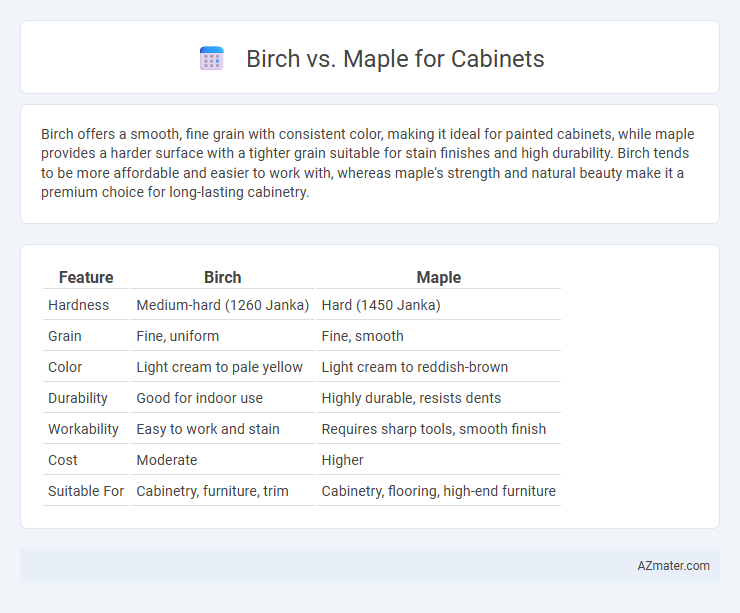Birch offers a smooth, fine grain with consistent color, making it ideal for painted cabinets, while maple provides a harder surface with a tighter grain suitable for stain finishes and high durability. Birch tends to be more affordable and easier to work with, whereas maple's strength and natural beauty make it a premium choice for long-lasting cabinetry.
Table of Comparison
| Feature | Birch | Maple |
|---|---|---|
| Hardness | Medium-hard (1260 Janka) | Hard (1450 Janka) |
| Grain | Fine, uniform | Fine, smooth |
| Color | Light cream to pale yellow | Light cream to reddish-brown |
| Durability | Good for indoor use | Highly durable, resists dents |
| Workability | Easy to work and stain | Requires sharp tools, smooth finish |
| Cost | Moderate | Higher |
| Suitable For | Cabinetry, furniture, trim | Cabinetry, flooring, high-end furniture |
Introduction to Birch and Maple Cabinets
Birch and maple cabinets both offer durable hardwood options prized for their strength and smooth finishes, making them popular choices in kitchen design. Birch features a fine grain with a pale yellow to light reddish-brown hue, providing a warm and inviting look, while maple is known for its consistent, light color palette and subtle grain patterns that create a clean, contemporary aesthetic. Both woods are versatile for staining and finishing, allowing customization to fit various interior styles and preferences.
Key Differences Between Birch and Maple Wood
Birch wood is typically lighter in color with a fine grain, offering a smooth and uniform texture ideal for modern cabinetry, while maple wood features a harder surface and a tighter, more pronounced grain pattern, making it more durable for heavy-use cabinets. Birch tends to be more affordable and easier to stain, providing flexibility in finishes, whereas maple's natural resistance to wear and its ability to hold intricate details make it preferred for high-end, long-lasting cabinetry. Both woods are strong and stable, but maple's superior hardness rating on the Janka scale (1450 vs. birch's 1260) contributes to its enhanced durability under repeated use.
Appearance and Grain Patterns
Birch cabinets feature a fine, uniform grain with subtle patterns, offering a smooth and consistent appearance that can range from creamy white to light yellow or reddish hues. Maple displays a more pronounced grain with occasional waves and subtle curls, providing a slightly more textured and varied look with colors from creamy white to light reddish-brown. Both woods create elegant cabinetry, but birch's even grain suits a modern, sleek aesthetic, while maple's dynamic grain adds warmth and visual interest to traditional or transitional designs.
Durability and Hardness Comparison
Birch wood offers a Janka hardness rating of around 1,260, making it moderately hard and resistant to dents and scratches in cabinet applications. Maple, with a higher Janka hardness of approximately 1,450, provides superior durability and robustness, ideal for high-traffic kitchen environments. The hardness difference means maple cabinets generally withstand wear and impact better than birch, enhancing longevity in daily use.
Cost and Affordability
Birch cabinets generally offer a more affordable option than maple, with prices typically ranging 10-20% lower due to faster growth rates and abundant availability. Maple cabinets provide greater durability and a smoother finish but come with a higher price tag, reflecting the wood's density and fine grain. Budget-conscious homeowners often choose birch for cost efficiency without sacrificing quality, while maple suits those prioritizing long-term investment and aesthetic appeal.
Workability and Ease of Installation
Birch offers superior workability due to its fine, uniform grain and consistent texture, allowing for smooth cutting, sanding, and finishing, which makes it ideal for detailed cabinetry. Maple is denser and harder, providing exceptional durability but requiring sharper tools and more effort during installation and shaping processes. Both woods hold hardware well, but birch's ease of machining often results in faster, more precise cabinet assembly compared to the heavier, tougher maple.
Finishing Options: Staining and Painting
Birch offers a smooth, consistent grain that readily absorbs stain, resulting in rich, even finishes ideal for traditional and varied color styles, while maple's dense, fine grain provides a light, uniform surface that excels with painting, delivering a sleek, contemporary look. Birch responds well to both opaque and transparent stains, enhancing its warm tones, whereas maple tends to resist staining unevenly, making it better suited for solid paint colors that highlight its smooth texture. Choosing between birch and maple for cabinetry depends largely on the desired finish effect, with birch favoring stained finishes and maple favoring painted applications.
Environmental Impact and Sustainability
Birch cabinets offer a sustainable choice due to their rapid growth rate and efficient use in managed forests, reducing deforestation impact compared to slower-growing hardwoods. Maple, while durable and dense, has a longer maturation period, which can lead to increased environmental strain if not sourced from certified sustainable forests. Selecting FSC-certified birch or maple ensures responsible harvesting practices that support forest regeneration and minimize ecological footprints.
Best Applications: Birch vs Maple Cabinets
Birch cabinets excel in modern kitchens and bathrooms due to their smooth, fine grain and light color, which easily accepts stains and paints for versatile finishes. Maple cabinets offer superior hardness and durability, making them ideal for high-traffic areas and traditional cabinetry requiring a smooth, uniform appearance. Both woods provide excellent cabinet solutions, with birch favored for cost-effective customization and maple prized for longevity and resistance to dents.
Which Wood to Choose: Birch or Maple?
Birch offers a smooth, fine grain and a light color that stains well, making it ideal for traditional and modern cabinetry with a consistent finish. Maple features a harder surface and a subtle grain pattern, providing durability and a sleek look suited for high-traffic areas. Choose birch for affordability and easy customization, while maple is best for long-lasting strength and a clean aesthetic in kitchen or bathroom cabinets.

Infographic: Birch vs Maple for Cabinet
 azmater.com
azmater.com